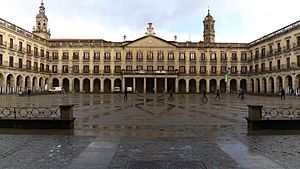Justo Antonio de Olaguibel facts for kids
Quick facts for kids
Justo Antonio de Olaguibel
|
|
|---|---|
| Born | 7th of August, 1752 Vitoria, Spain
|
| Died | 11th of February, 1818 Vitoria, Spain
|
| Nationality | Spanish |
| Known for | Famous architect in Vitoria |
Justo Antonio de Olaguibel was a famous Spanish architect. He was born in Vitoria, Spain, on August 7, 1752. He passed away in Vitoria on February 11, 1818. Olaguibel was a very important architect. He was known for his Neoclassic style in the Basque Country. Neoclassic means his buildings looked like ancient Greek or Roman designs.
He went to school at the Image School in Vitoria. He also studied at the Royal San Fernando Academy in Madrid. This is a famous art school in Spain. Justo Antonio designed many well-known places in Vitoria. These include Los Arquillos and the Plaza España. He also planned two important roads in 1792 and 1793.
Contents
About Justo Antonio de Olaguibel
Early Life and Education
Justo Antonio de Olaguibel's family came from Durango. But by the 1700s, they lived in Vitoria. His family was involved in building things. Justo Antonio's father was a master builder. He really cared about his son's future.
So, he enrolled Justo Antonio in the Drawing School in Vitoria when he was young. This school was part of the Real Sociedad Bascongada de Amigos del País. His father wanted him to learn building design in a proper way. Justo Antonio was a very quick learner. He was one of the best students. This encouraged him to apply to the Royal San Fernando Academy of Fine Art in Madrid. He wanted to learn even more about architecture. He also wanted to get the official qualifications he needed.
Becoming a Famous Architect
In 1781, the mayor of Vitoria, Ramón María de Urbina, asked Olaguibel to design the Plaza Nueva. Today, this is known as Plaza de España. It was the first Neoclassic square in Vitoria. This square became a model for other main squares. These included squares in Tudela, San Sebastian, and Bilbao. The Plaza de España became the main center of Vitoria.
However, the new square was on a different level than the old part of the city. There was a slope between them. So, in 1790, Olaguibel designed Los Arquillos. This was a clever solution to connect the two parts. It joined the square with the old city in a beautiful way. Los Arquillos has balconies and platforms with stairs. Olaguibel wanted to connect the old and new parts of Vitoria smoothly.
These two projects made Olaguibel very famous. He brought the first Neoclassic buildings to Vitoria. He also introduced this style to the whole Basque Country.
Designing Churches and Convents
After creating Plaza de España and Los Arquillos, Olaguibel started focusing on religious buildings. After 1794, he designed arcades, towers, and smaller structures. Many of these were in villages in the Alava area. His career was doing very well. But because he focused on religious works, other architects started building in Vitoria.
Justo Antonio de Olaguibel never worked for the government. But he knew important people of his time. One of them was Samaniego.
Olaguibel spent a lot of effort on the front of the Magdalena Convent. This was in 1783. The convent was where the New Cathedral of Vitoria is now. But they decided not to tear down the convent's front. Instead, it was moved to Vicente Goikoetxea street. Fausto Iñiguez de Betolaza was in charge of moving it.
Later Life and Works
In 1789, the architect built the San Andrés church in Elciego. This building showed how skilled he was. In 1806, before the Peninsular War, Olaguibel designed a house. It was for Bishop Juan Joé Díaz de Espada in Armentia.
Justo Antonio de Olaguibel died in Vitoria on February 11, 1818.
Important Buildings Designed by Olaguibel
- Plaza España, Vitoria (1781–1791)
- Facade of the Magdalena convent, Vitoria (1783)
- Tower and arcade from Done Bikendi church in Arriaga, Vitoria (1787)
- Town Hall, Orendain (1787)
- San Andres Church, Elciego (1789)
- Town Hall, Leintz Gatzaga (1789)
- Los Arquillos, Vitoria (1790)
- Public fountain, Haro
- Arcade of the church, Aberasturi (1801)
- House of bishop José Díaz Espada, Armentia (1806)
See also
 In Spanish: Justo Antonio de Olaguíbel para niños
In Spanish: Justo Antonio de Olaguíbel para niños


